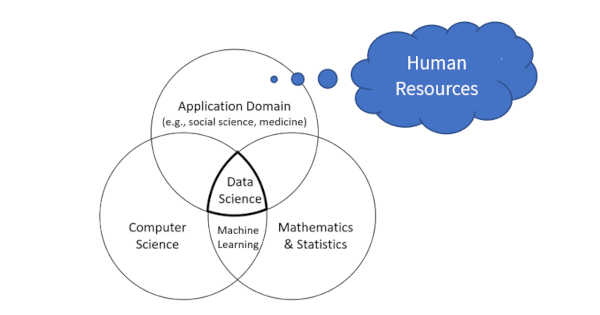Setting
Data science is an interdisciplinary field that integrates knowledge and practices from three perspectives: computer science, mathematics and statistics, and the application domain. In this blog, I focus on people analytics, specifically on the case in which the application domain is human resources (see Figure 1), and I describe a workshop on people analytics applications that I taught to 25 senior undergraduate computer science students at the Blavatnik School of Computer Science at Tel Aviv University, during my sabbatical in the Spring 2023 semester.
Figure 1. A Venn diagram for data science (Hazzan and Mike, 2023) for the case of people analytics.
The purpose of this blog is to illustrate how this interdisciplinary topic opens students to a variety of topics.
People analytics – what does it deal with?
People analytics deals with the application of data science methods and machine learning algorithms for a variety of purposes in the domain of human resources. Specifically, people analytics explores how organizations can improve their performance by analyzing data related to their candidates and employees. Consequently, it fosters collaboration between human resources practitioners and data scientists.
Furthermore, people analytics enables human resources departments to derive data-driven conclusions on a variety of topics such as talent acquisition and management (including the process of identifying, attracting, and hiring new employees and retaining top talent within an organization); workforce processes (e.g., employees’ impact on business goals, employee performance, and workforce productivity); the effectiveness of human resources initiatives, such as wellness and learning programs; and retention efforts and turnover, which are the ability of an organization to keep its employees over time and the rate at which employees leave an organization, respectively.
Workshop description
Twenty-five computer science senior students participated in the Workshop on People Analytics Applications in the framework of one of their capstone courses. In such workshops, students are expected to gain preliminary experience in conducting research on a topic oftheir choice. Specifically, in this workshop, the students are expected to learn the knowledge relevant to their research topic in human resources and to examine it applying their knowledge in computer science in general, and specifically in machine learning.
Since not all 25 students had a background in human resources (the application domain in the case of people analytics), and since their background in computer science and data science was on different levels (due to their different study programs), the workshop also included several software engineering topics and data science topics. Accordingly, the main topics addressed in the workshop were: selected topics in people analytics, selected topics in data science, data science as a research approach/method, and agile project development.
Students were expected to invest five weekly hours in their project, totaling about 65-70 hours for the entire semester, in addition to the 1.5-hour weekly lesson. Projects were developed in teams of two or three students. As part of the project development requirements, students were asked to continuously estimate the development time of each task and record the actual time it took.
Table 1 presents the workshop schedule. In the spirit of the agile approach, project development was carried out in three iterations. The first iteration was called “set the stage,” the second iteration was called “be aware,” and the third iteration was “delve and explore.”
Table 1: The schedule of the Workshop of People Analytics Applications, Blavatnik School of Computer Science, Tel Aviv University, Spring 2023 Semester
|
Iteration # |
Week |
Date- 2023 |
Content |
|
1 – Set the stage |
1 |
16.3 |
Introduction Overview – Data science
– People analytics
|
|
|
2 |
23.3 |
Data science as a research method: Application to people analytics |
|
|
3 |
30.3 |
Agile development: Implementation on the course structure and project development |
|
|
4 |
20.4 |
Iteration 1 presentations |
|
2 – Be aware |
5 |
27.4 |
• Cognitive and social biases
• Iteration 1 follow-up
|
|
|
6 |
4.5 |
• Data science skills (1)
• Data science ethics
• Iteration 2 content
|
|
|
7 |
11.5 |
• Cognitive and social biases
• Data science skills (2)
|
|
|
8 |
18.5 |
Iteration 2 presentations |
|
3 – Delve and explore
|
9 |
1.6 |
• Invited talk: Dr. Nava Michael Tsabari, Coller School of Management, Tel Aviv University: Emotions in Organizations
• Requirements of the final project submission and final presentations
|
|
|
10 |
8.6 |
Project development – No class |
|
|
11 |
15.6 |
Project development – No class |
|
|
12 |
22.6 |
Iteration 3 presentations |
|
End of semester |
13 |
29.6 |
Final presentation and scheduling final project submission |
As mentioned, for their final projects, the students were requested to choose a topic in human analytics, research it, and submit a research report.
The requirements of the final project submission, as presented to the students, are:
Grading
80%: Teamwork (joint project report up to 12 pages, excluding cover page, table of content, references, and appendices)
20%: Individual work (individual report up to 2 pages each) – see details below
Teamwork
A report that summarizes the research you conducted, making sure to cover the common parts of a research report:
- Theoretical background
- Research problem
- Research target
- Research questions
- Research method: Population, research process (see Comment 1, below), data collection tools (see Comment 2, below), data analysis method(s), ethical considerations, and research limitations
- Findings
- Discussion: Research contribution (theoretical and practical) and limitations
- Conclusion and follow up research
Comments
- In the description of the research process, please also describe steps/phases that were not successful and why, doubts you had during the research, and decision-making methods/principles that guided you.
- The data collection must include at least two tools – one manual (survey, interviews, etc.) and the other automatic, either web scraping or some other large database from the many databases available.
Personal work
The individual work has no defined requirements. You can share the learning process (with respect to the field of knowledge, research process, your own skills), various professional thoughts, and anything else that seems relevant to you as a summary of the process. The individual works can be submitted at the end of the group work report or in separate files by each of the team members.
Following are several topics raised in class. These are only suggestions; other issues may of course be addressed.
Guidelines for individual assignments
1) Teamwork:
a. What was your role in the team?
b. What was your experience working as a team?
c. How was the communication between the team members?
2) Researching people analytics:
a. What was your experience learning about the subject of your research?
b. Describe your experience in conducting research.
3) How was the experience working in the agile technique?
The research topics the students selected can be sorted into three categories:
- Their studies: Teams #1, 3, and 7
- Team #1: The predictability of the number of years it will take a student to complete their degree in computer science
- Team #3: Factors that predict good computer science master’s student
- Team #7: Reassessing the necessity of a degree in computer science or engineering for entry into the hi-tech industry
- The hi-tech industry: Teams #2, 4, 6, and 8
- Team #2: Correlation between the presence of companies on social networks and their public reputation
- Team #4: Automating the initial evaluation of CVs based on job descriptions
- Team #6: Predicting benefits and their attraction to employees in the Israeli hi-tech industry according to demographic characteristics
- Team #8: Income and happiness: Exploring the link between income and happiness, specifically within the context of hi-tech companies
- Gender issues: Teams #5 (3 men) and 9 (2 women)
- Team #5: Gender differences in the hi-tech industry
- Team #9: Gender bias in job descriptions within the software engineering industry*
*Note: Team #9 developed the project in collaboration with several master’s students who were studying human resources management. See my co-authored blogs with Dafna Gelbgiser: Teaching Data Science Research Methods to Human Resources Practitioners: Part 1, Part 2, Part 3, Part 4.
Machine learning techniques the students used in their projects included: Web scraping, classification, decision trees, random forest, OLS linear regression, light gradient boosting, and naive Bayes classifier. Data was obtained from a variety of data sources, including both online resources (e.g., company websites, LinkedIn (manually), Kaggle, arXiv, Google Scholar, employee reviews) and surveys the students distributed.
In what follows
In Part 2 of this blog, I present excerpts from students’ reflections on their final research projects to illustrate the learning opportunities that such research projects open up for computer science students and the variety of skills they enable students to acquire.
References
Hazzan, O. and Mike, K. (2023). Guide to Teaching Data Science: An Interdisciplinary Approach, Springer. https://link.springer.com/book/10.1007/978-3-031-24758-3#toc.
Orit Hazzan is a professor at the Technion’s Department of Education in Science and Technology. Her research focuses on computer science, software engineering, and data science education. For additional details, see https://orithazzan.net.technion.ac.il/.





Join the Discussion (0)
Become a Member or Sign In to Post a Comment